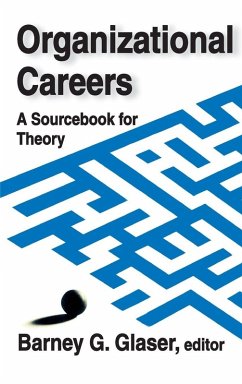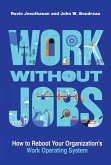- Gebundenes Buch
- Merkliste
- Auf die Merkliste
- Bewerten Bewerten
- Teilen
- Produkt teilen
- Produkterinnerung
- Produkterinnerung
Although sociologists have written extensively on the broad subject of occupational careers, generally they have referred only incidentally to organizational careers within work organizations
Andere Kunden interessierten sich auch für
![Work Without Jobs: How to Reboot Your Organization's Work Operating System Work Without Jobs: How to Reboot Your Organization's Work Operating System]() Ravin JesuthasanWork Without Jobs: How to Reboot Your Organization's Work Operating System22,99 €
Ravin JesuthasanWork Without Jobs: How to Reboot Your Organization's Work Operating System22,99 €![Professions, Work and Careers Professions, Work and Careers]() Anselm L StraussProfessions, Work and Careers180,99 €
Anselm L StraussProfessions, Work and Careers180,99 €![Slow Productivity Slow Productivity]() Cal NewportSlow Productivity14,24 €
Cal NewportSlow Productivity14,24 €![The Origins of Economic Democracy The Origins of Economic Democracy]() Michael PooleThe Origins of Economic Democracy140,99 €
Michael PooleThe Origins of Economic Democracy140,99 €![Workers' Control Workers' Control]() Ernie RobertsWorkers' Control170,99 €
Ernie RobertsWorkers' Control170,99 €![Employability Employability]() Michele BaukensEmployability187,99 €
Michele BaukensEmployability187,99 €![How Changing World Demographics Affects Your Investments and Careers How Changing World Demographics Affects Your Investments and Careers]() Rainier George WeinerHow Changing World Demographics Affects Your Investments and Careers30,99 €
Rainier George WeinerHow Changing World Demographics Affects Your Investments and Careers30,99 €-
-
-
Although sociologists have written extensively on the broad subject of occupational careers, generally they have referred only incidentally to organizational careers within work organizations
Hinweis: Dieser Artikel kann nur an eine deutsche Lieferadresse ausgeliefert werden.
Hinweis: Dieser Artikel kann nur an eine deutsche Lieferadresse ausgeliefert werden.
Produktdetails
- Produktdetails
- Verlag: Taylor & Francis
- Seitenzahl: 480
- Erscheinungstermin: 13. Juli 2017
- Englisch
- Abmessung: 229mm x 152mm x 27mm
- Gewicht: 807g
- ISBN-13: 9781138529403
- ISBN-10: 1138529400
- Artikelnr.: 49209619
- Herstellerkennzeichnung
- Libri GmbH
- Europaallee 1
- 36244 Bad Hersfeld
- gpsr@libri.de
- Verlag: Taylor & Francis
- Seitenzahl: 480
- Erscheinungstermin: 13. Juli 2017
- Englisch
- Abmessung: 229mm x 152mm x 27mm
- Gewicht: 807g
- ISBN-13: 9781138529403
- ISBN-10: 1138529400
- Artikelnr.: 49209619
- Herstellerkennzeichnung
- Libri GmbH
- Europaallee 1
- 36244 Bad Hersfeld
- gpsr@libri.de
Barney Glaser
Introduction
I: Toward a Theory of Organizational Careers
1: Career and Office
2: Careers Personality, and Adult Socialization
3: The Study of the Career Timetables
4: Careers, Life-Styles, and Social Integration
II: Recruitment to Organizational Careers
5: The Recruitment of Industrial Scientists
6: Recruitment to the Academic Career
7: Procedures of Academic Recruitment
8: Recruiting Volunteers
9: Recruitment of Wall Street Lawyers
III: Career Motivations within the Organization
10: Professional Incentives in Industry
11: Military Career Motivations
12: Career Development of Scientists
13: Careerist Types
14: Prestige Grading: A Mechanism of Control
15: Aspirations of Telephone Workers
16: The Chronology of Aspirations of Automobile Workers
IV: Loyalty and Commitment to the Organizational Career
17: Cosmopolitan and Locals
18: Reference Groups and Loyalties in the Out-Patient Department
19: Enculturation in Industrial Research
20: Career Concerns and Footholds in the Organization
21: The Expansion Orientation of Supervisors of Research
22: Career Mobility and Organizational Commitment
V: Sources and Strategies of Promotion
23: Success
24: The Accumulation of Advantages vs. the Bureaucratic Crawl
25: Patterns of Mobility within Industrial Organizations
26: Military Tactics of Promotion
27: Selecting Law Partners
28: The Airline Pilot's Career Timetable
29: Publish or Perish
30: Informal Factors in Career Achievement
31: Sponsorship and Rejection
32: Sponsorship in the Medical Profession
33: The Negro Union Official: A Study of Sponsorship and Control
34: Advancement in the Japanese Factory
VI: Managing Demotion
35: Consequences of Failure in Organizations
36: Demotion in Industrial Management
37: Comparative Failure in Science
38: Demotion
39: Moving Up and Down in the World
40: Incompetence in the Japanese Factory
41: "Failures" Who Stay with the Law Firm
42: Demotion and Sinecure Offices
VII: Organizational Succession
43: The Problem of Succession in Bureaucracy
44: Regularized Status-Passage
45: Vacant Position and Promotion
46: How Vacancies Occur in Academic Careers
47: Weeding Out Lawyers
48: Bureaucratic Succession
49: The Problem of Generations in an Organizational Structure
50: The Effects of Succession: A Comparative Study of Military and Business Organization
51: Executive Succession in Small Companies
VIII: Moving between Organizations
52: The Career of the Schoolteacher
53: Touristry: A Type of Occupational Mobility
54: Compliance Specialization and Executive Mobility
55: Security and Alternative Career Possibilities in Other Organizations
56: Internship Appointments of Medical Students
IX: Executive and Worker Career Patterns
57: The Chief Executives
58: Self-Made Men
59: The Elite Military Nucleus
60: Organizational Career Patterns of Business Leaders
61: Career Patterns of Manual Workers
62: The Career of the Letter Carrier
63: From Organizational Career to Private Practice
I: Toward a Theory of Organizational Careers
1: Career and Office
2: Careers Personality, and Adult Socialization
3: The Study of the Career Timetables
4: Careers, Life-Styles, and Social Integration
II: Recruitment to Organizational Careers
5: The Recruitment of Industrial Scientists
6: Recruitment to the Academic Career
7: Procedures of Academic Recruitment
8: Recruiting Volunteers
9: Recruitment of Wall Street Lawyers
III: Career Motivations within the Organization
10: Professional Incentives in Industry
11: Military Career Motivations
12: Career Development of Scientists
13: Careerist Types
14: Prestige Grading: A Mechanism of Control
15: Aspirations of Telephone Workers
16: The Chronology of Aspirations of Automobile Workers
IV: Loyalty and Commitment to the Organizational Career
17: Cosmopolitan and Locals
18: Reference Groups and Loyalties in the Out-Patient Department
19: Enculturation in Industrial Research
20: Career Concerns and Footholds in the Organization
21: The Expansion Orientation of Supervisors of Research
22: Career Mobility and Organizational Commitment
V: Sources and Strategies of Promotion
23: Success
24: The Accumulation of Advantages vs. the Bureaucratic Crawl
25: Patterns of Mobility within Industrial Organizations
26: Military Tactics of Promotion
27: Selecting Law Partners
28: The Airline Pilot's Career Timetable
29: Publish or Perish
30: Informal Factors in Career Achievement
31: Sponsorship and Rejection
32: Sponsorship in the Medical Profession
33: The Negro Union Official: A Study of Sponsorship and Control
34: Advancement in the Japanese Factory
VI: Managing Demotion
35: Consequences of Failure in Organizations
36: Demotion in Industrial Management
37: Comparative Failure in Science
38: Demotion
39: Moving Up and Down in the World
40: Incompetence in the Japanese Factory
41: "Failures" Who Stay with the Law Firm
42: Demotion and Sinecure Offices
VII: Organizational Succession
43: The Problem of Succession in Bureaucracy
44: Regularized Status-Passage
45: Vacant Position and Promotion
46: How Vacancies Occur in Academic Careers
47: Weeding Out Lawyers
48: Bureaucratic Succession
49: The Problem of Generations in an Organizational Structure
50: The Effects of Succession: A Comparative Study of Military and Business Organization
51: Executive Succession in Small Companies
VIII: Moving between Organizations
52: The Career of the Schoolteacher
53: Touristry: A Type of Occupational Mobility
54: Compliance Specialization and Executive Mobility
55: Security and Alternative Career Possibilities in Other Organizations
56: Internship Appointments of Medical Students
IX: Executive and Worker Career Patterns
57: The Chief Executives
58: Self-Made Men
59: The Elite Military Nucleus
60: Organizational Career Patterns of Business Leaders
61: Career Patterns of Manual Workers
62: The Career of the Letter Carrier
63: From Organizational Career to Private Practice
Introduction
I: Toward a Theory of Organizational Careers
1: Career and Office
2: Careers Personality, and Adult Socialization
3: The Study of the Career Timetables
4: Careers, Life-Styles, and Social Integration
II: Recruitment to Organizational Careers
5: The Recruitment of Industrial Scientists
6: Recruitment to the Academic Career
7: Procedures of Academic Recruitment
8: Recruiting Volunteers
9: Recruitment of Wall Street Lawyers
III: Career Motivations within the Organization
10: Professional Incentives in Industry
11: Military Career Motivations
12: Career Development of Scientists
13: Careerist Types
14: Prestige Grading: A Mechanism of Control
15: Aspirations of Telephone Workers
16: The Chronology of Aspirations of Automobile Workers
IV: Loyalty and Commitment to the Organizational Career
17: Cosmopolitan and Locals
18: Reference Groups and Loyalties in the Out-Patient Department
19: Enculturation in Industrial Research
20: Career Concerns and Footholds in the Organization
21: The Expansion Orientation of Supervisors of Research
22: Career Mobility and Organizational Commitment
V: Sources and Strategies of Promotion
23: Success
24: The Accumulation of Advantages vs. the Bureaucratic Crawl
25: Patterns of Mobility within Industrial Organizations
26: Military Tactics of Promotion
27: Selecting Law Partners
28: The Airline Pilot's Career Timetable
29: Publish or Perish
30: Informal Factors in Career Achievement
31: Sponsorship and Rejection
32: Sponsorship in the Medical Profession
33: The Negro Union Official: A Study of Sponsorship and Control
34: Advancement in the Japanese Factory
VI: Managing Demotion
35: Consequences of Failure in Organizations
36: Demotion in Industrial Management
37: Comparative Failure in Science
38: Demotion
39: Moving Up and Down in the World
40: Incompetence in the Japanese Factory
41: "Failures" Who Stay with the Law Firm
42: Demotion and Sinecure Offices
VII: Organizational Succession
43: The Problem of Succession in Bureaucracy
44: Regularized Status-Passage
45: Vacant Position and Promotion
46: How Vacancies Occur in Academic Careers
47: Weeding Out Lawyers
48: Bureaucratic Succession
49: The Problem of Generations in an Organizational Structure
50: The Effects of Succession: A Comparative Study of Military and Business Organization
51: Executive Succession in Small Companies
VIII: Moving between Organizations
52: The Career of the Schoolteacher
53: Touristry: A Type of Occupational Mobility
54: Compliance Specialization and Executive Mobility
55: Security and Alternative Career Possibilities in Other Organizations
56: Internship Appointments of Medical Students
IX: Executive and Worker Career Patterns
57: The Chief Executives
58: Self-Made Men
59: The Elite Military Nucleus
60: Organizational Career Patterns of Business Leaders
61: Career Patterns of Manual Workers
62: The Career of the Letter Carrier
63: From Organizational Career to Private Practice
I: Toward a Theory of Organizational Careers
1: Career and Office
2: Careers Personality, and Adult Socialization
3: The Study of the Career Timetables
4: Careers, Life-Styles, and Social Integration
II: Recruitment to Organizational Careers
5: The Recruitment of Industrial Scientists
6: Recruitment to the Academic Career
7: Procedures of Academic Recruitment
8: Recruiting Volunteers
9: Recruitment of Wall Street Lawyers
III: Career Motivations within the Organization
10: Professional Incentives in Industry
11: Military Career Motivations
12: Career Development of Scientists
13: Careerist Types
14: Prestige Grading: A Mechanism of Control
15: Aspirations of Telephone Workers
16: The Chronology of Aspirations of Automobile Workers
IV: Loyalty and Commitment to the Organizational Career
17: Cosmopolitan and Locals
18: Reference Groups and Loyalties in the Out-Patient Department
19: Enculturation in Industrial Research
20: Career Concerns and Footholds in the Organization
21: The Expansion Orientation of Supervisors of Research
22: Career Mobility and Organizational Commitment
V: Sources and Strategies of Promotion
23: Success
24: The Accumulation of Advantages vs. the Bureaucratic Crawl
25: Patterns of Mobility within Industrial Organizations
26: Military Tactics of Promotion
27: Selecting Law Partners
28: The Airline Pilot's Career Timetable
29: Publish or Perish
30: Informal Factors in Career Achievement
31: Sponsorship and Rejection
32: Sponsorship in the Medical Profession
33: The Negro Union Official: A Study of Sponsorship and Control
34: Advancement in the Japanese Factory
VI: Managing Demotion
35: Consequences of Failure in Organizations
36: Demotion in Industrial Management
37: Comparative Failure in Science
38: Demotion
39: Moving Up and Down in the World
40: Incompetence in the Japanese Factory
41: "Failures" Who Stay with the Law Firm
42: Demotion and Sinecure Offices
VII: Organizational Succession
43: The Problem of Succession in Bureaucracy
44: Regularized Status-Passage
45: Vacant Position and Promotion
46: How Vacancies Occur in Academic Careers
47: Weeding Out Lawyers
48: Bureaucratic Succession
49: The Problem of Generations in an Organizational Structure
50: The Effects of Succession: A Comparative Study of Military and Business Organization
51: Executive Succession in Small Companies
VIII: Moving between Organizations
52: The Career of the Schoolteacher
53: Touristry: A Type of Occupational Mobility
54: Compliance Specialization and Executive Mobility
55: Security and Alternative Career Possibilities in Other Organizations
56: Internship Appointments of Medical Students
IX: Executive and Worker Career Patterns
57: The Chief Executives
58: Self-Made Men
59: The Elite Military Nucleus
60: Organizational Career Patterns of Business Leaders
61: Career Patterns of Manual Workers
62: The Career of the Letter Carrier
63: From Organizational Career to Private Practice








